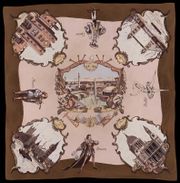Difference between revisions of "Cellulose triacetate"
(username removed) |
|||
| (3 intermediate revisions by 3 users not shown) | |||
| Line 1: | Line 1: | ||
| + | [[File:Triacetate scarf MFA.jpg|thumb|Triacetate scarf<br>MFA# 2001.2388]] | ||
== Description == | == Description == | ||
| − | [ | + | [[Cellulose acetate]] resin with more than 92% of the hydroxyls replaced with acetate. Cellulose triacetate was first developed by Schutzenberger in 1865. However, it was a tough hard plastic that contained high amounts of acids and was only soluble in expensive chlorinated solvents. Small amounts of triacetate film were produced by Eastman-Kodak in 1908. Fiber production from cellulose triacetate was not commercially viable until the mid-1950s when economical solvents became available. Triacetate is a durable fiber that is resistant to wrinkles, stains, chemicals, sunlight, insects and moisture. It should not be dry-cleaned but is not degraded by normal laundering. It dries quickly in air or cool driers and maintains its shape without ironing. Triacetate is a crisp, firm fabric that is often used in taffetas and suitings. It is used in drip-dry clothing, tablecloths, skirts and slacks. It is often used in wool blends to increase washability and crease retention. |
== Synonyms and Related Terms == | == Synonyms and Related Terms == | ||
| Line 7: | Line 8: | ||
cellulose acetate; CTA; triacetate; triacetato de celulosa (Esp.); triacétate de cellulose (Fr.); cellulose triacetaat (Ned); Arnel® [Celanese, America]; Tricel [British Celanese]; Trilan; primary acetate; JPS [Courtaulds]; Courpleta [Courtaulds] | cellulose acetate; CTA; triacetate; triacetato de celulosa (Esp.); triacétate de cellulose (Fr.); cellulose triacetaat (Ned); Arnel® [Celanese, America]; Tricel [British Celanese]; Trilan; primary acetate; JPS [Courtaulds]; Courpleta [Courtaulds] | ||
| − | == | + | == Physical and Chemical Properties == |
| − | Soluble in chloroform, methylene chloride, m-cresol, 90% phenol. Insoluble in acetone. Unaffected by dilute acids, alkalis and bleaches | + | Soluble in chloroform, methylene chloride, m-cresol, 90% phenol. Insoluble in acetone. Unaffected by dilute acids, alkalis and bleaches. |
| − | + | Tenacity = 1.1-1.4 g/denier (dry); 0.7-0.8 g/denier (wet); Elongation 25-30% (dry); 30-40% (wet); Moisture regain = 2.5-3.5%; Melting Point = 300; Density = 1.32 | |
| − | |||
| − | |||
| − | |||
| − | |||
| − | |||
| − | |||
| − | |||
| − | |||
| − | |||
| − | |||
| − | |||
== Comparisons == | == Comparisons == | ||
| Line 28: | Line 18: | ||
[[media:download_file_42.pdf|Properties of Synthetic Fibers]] | [[media:download_file_42.pdf|Properties of Synthetic Fibers]] | ||
| − | + | == Resources and Citations == | |
| − | |||
| − | == | ||
* G.S.Brady, ''Materials Handbook'', McGraw-Hill Book Co., New York, 1971 Comment: p. 170 | * G.S.Brady, ''Materials Handbook'', McGraw-Hill Book Co., New York, 1971 Comment: p. 170 | ||
| Line 36: | Line 24: | ||
* ''Van Nostrand's Scientific Encyclopedia'', Douglas M. Considine (ed.), Van Nostrand Reinhold, New York, 1976 | * ''Van Nostrand's Scientific Encyclopedia'', Douglas M. Considine (ed.), Van Nostrand Reinhold, New York, 1976 | ||
| − | * Wikipedia | + | * Wikipedia: http://en.wikipedia.org/wiki/Cellulose_triacetate (Accessed Jan. 15, 2006) |
* J.Gordon Cook, ''Handbook of Textile Fibres:II Man-made Fibres'', Merrow Publishing Co. , Durham, England | * J.Gordon Cook, ''Handbook of Textile Fibres:II Man-made Fibres'', Merrow Publishing Co. , Durham, England | ||
Latest revision as of 10:47, 19 October 2020
Description
Cellulose acetate resin with more than 92% of the hydroxyls replaced with acetate. Cellulose triacetate was first developed by Schutzenberger in 1865. However, it was a tough hard plastic that contained high amounts of acids and was only soluble in expensive chlorinated solvents. Small amounts of triacetate film were produced by Eastman-Kodak in 1908. Fiber production from cellulose triacetate was not commercially viable until the mid-1950s when economical solvents became available. Triacetate is a durable fiber that is resistant to wrinkles, stains, chemicals, sunlight, insects and moisture. It should not be dry-cleaned but is not degraded by normal laundering. It dries quickly in air or cool driers and maintains its shape without ironing. Triacetate is a crisp, firm fabric that is often used in taffetas and suitings. It is used in drip-dry clothing, tablecloths, skirts and slacks. It is often used in wool blends to increase washability and crease retention.
Synonyms and Related Terms
cellulose acetate; CTA; triacetate; triacetato de celulosa (Esp.); triacétate de cellulose (Fr.); cellulose triacetaat (Ned); Arnel® [Celanese, America]; Tricel [British Celanese]; Trilan; primary acetate; JPS [Courtaulds]; Courpleta [Courtaulds]
Physical and Chemical Properties
Soluble in chloroform, methylene chloride, m-cresol, 90% phenol. Insoluble in acetone. Unaffected by dilute acids, alkalis and bleaches.
Tenacity = 1.1-1.4 g/denier (dry); 0.7-0.8 g/denier (wet); Elongation 25-30% (dry); 30-40% (wet); Moisture regain = 2.5-3.5%; Melting Point = 300; Density = 1.32
Comparisons
Properties of Synthetic Fibers
Resources and Citations
- G.S.Brady, Materials Handbook, McGraw-Hill Book Co., New York, 1971 Comment: p. 170
- Van Nostrand's Scientific Encyclopedia, Douglas M. Considine (ed.), Van Nostrand Reinhold, New York, 1976
- Wikipedia: http://en.wikipedia.org/wiki/Cellulose_triacetate (Accessed Jan. 15, 2006)
- J.Gordon Cook, Handbook of Textile Fibres:II Man-made Fibres, Merrow Publishing Co. , Durham, England
- Marjorie Shelley, The Care and Handling of Art Objects, The Metropolitan Museum, New York, 1987
- Marjory L. Joseph, Introductory Textile Science, Holt, Rinehart and Winston, Fort Worth, TX, 1986
- Identification of Textile Materials, The Textile Institute, Manchester, England, 1985
